Last updated: September 19, 2025
Article
Ada Blackjack: Stranded on Wrangel Island
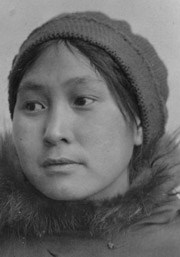
By Wilfrid Laurier University, Canada, Public Domain
“If anything happen to me and my death is known, there is black stirp for bennett school book bag, for my only son. I wish if you please take everything to Bennett that is belong to me. I don’t know how much I would be glad to get home to folks.”
- From the diary of Ada Blackjack, dated April 1, 1923
The Beginning
Ada Blackjack Johnson, born Ada Deletuk, was born in 1898 in Spruce Creek, a small settlement 8 miles outside the village of Solomon and 40 miles east of Nome, Alaska. Her mother moved her to Nome at the age of eight, where she was raised in a Methodist missionary school and taught to read, write, cook, and sew. At 16, Ada married Jack Blackjack. She gave birth to three children, but tragically, only her son, Bennett, survived past infancy.
Life with Jack Blackjack was miserable. He abused and eventually deserted Ada and her son only five years after they were married. Ada was alone and penniless, and Bennett suffered from chronic tuberculosis. With nowhere else to go, Ada walked over 40 miles from Spruce Creek to Nome, carrying her ailing son most of the way. Ada was forced to place him in a Nome orphanage while she sought employment as a seamstress. She worked tirelessly to make enough money to get him back.
Expedition to Wrangel Island
When famed explorer Vilhjalmur Stefansson came to Nome in 1921 looking for English-speaking Alaska Native families to join an expedition to Wrangel Island, Ada jumped at the opportunity. He offered a salary of $50 per month, an amount unheard of to her at the time, and she was desperate to reunite with her son. However, many people in Nome had serious doubts about the mission.
Wrangel Island is a large, remote island in the Chukchi Sea north of Siberia. At the time, various claims for the island had been made by Canada, Russia, the United Kingdom, and the United States, but none stood firm. Stefansson believed that only continuous settlement on Wrangel Island would safeguard a claim. He was gripped by ambition to further his legacy as a celebrated explorer and investigate new economic opportunities in what he called “The Friendly Arctic.” He strategized that a small expedition party living on the island for two years would solidify a claim, and after asking Canada, the United Kingdom, and the United States, the Canadian government reluctantly agreed to fund the initial voyage.
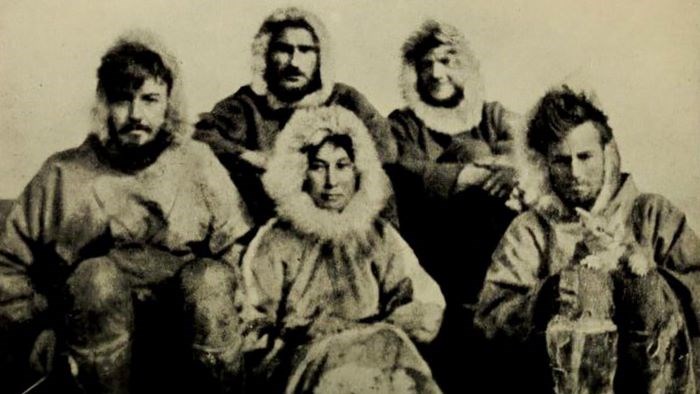
Image from "The Adventure of Wrangel Island" by Vilhjalmur Stefansson, Public Domain
Even with Stefansson’s eagerness, it quickly became clear to Ada that he would not join the expedition to Wrangel Island. Instead, he had recruited Allan Crawford, Milton Galle, Fred Maurer, and Lorne Knight to carry out the expedition on his behalf. Stefansson discouraged them from bringing more than 6 months' worth of supplies. He assured them that game would be plentiful on the island, and the men, with little experience of their own, were inclined to believe him.
23-year-old Ada was terrified. She had a deep fear of polar bears and was extremely uneasy at the idea of being stranded for several months alone with unknown men. To make things worse, the other Alaska Native families who agreed to join the expedition ultimately backed out, making her the only Inupiaq and only woman present. But Ada needed the money. If she joined the expedition, she would return to Nome with enough to reclaim her son from the orphanage.
On September 9, 1921, the expedition group left for Wrangel Island. Ada and the four men were also joined by their “expedition kitten” named Victoria, or Vic for short. The cat had been born on the ship the men had taken to Nome and was given to them by the ship’s captain. They took her with them on the expedition, proclaiming that she was their good luck charm.
When the group landed at Wrangel Island, the men celebrated their arrival, but as the ship that had brought them to the island left, Ada was silent. She walked alone to the gravel beach, watched the ship fade into the distance, and wept. Struggling in the new environment and feeling threatened by the others, Ada became extremely anxious and withdrawn, which led to her neglecting the duties of cooking, cleaning, and sewing. This, in turn, caused them to grow more and more aggressive towards her.
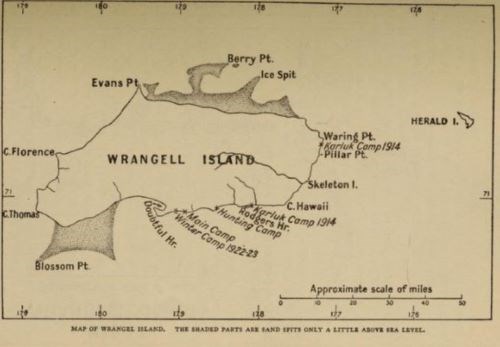
Image from "The Adventure of Wrangel Island" by Vilhjalmur Stefansson, Public Domain
But Ada Blackjack persevered. She decided resolutely that she needed to survive for her son, and the fog eventually lifted. She threw herself into her work, and as winter descended, the five people and one cat united on Wrangel Island.“The seamstress refused to patch a pair of boots to-day, so I tied her to the flagpole until she promised to repair them. Kindness failing to accelerate, I am trying something more forceful.”
- From the diary of Lorne Knight, dated November 23, 1921.
Summer and the eventual break-up of sea ice finally came, and the group eagerly awaited the arrival of their relief ship. However, the summer of 1922 came and went, and no ship broke through the horizon. The new Bolshevik government of Russia had decided to officially make a claim to Wrangel Island, and the Canadian government, which had funded the original voyage, was reluctant to challenge them. Stefansson was forced to seek outside investors to fund the relief ship. By the time he came up with the funds, the sea ice had already blocked the ship’s passage to Wrangel Island.
As cold descended yet again, the group’s supplies had dwindled significantly, and without the supplies scheduled to arrive on the summer relief ship, they were left with very little. Although Stefansson promised there would be ample game to hunt on the island, the group found this was not the case. They struggled to find enough food to sustain themselves, and they were running out of ammunition. They grew weaker and weaker, especially Lorne Knight, who was showing alarming signs of scurvy.
In desperation, Crawford, Maurer, and Galle took the group’s remaining sled dogs across the sea ice towards Siberia in January 1923, searching for help. The three men were never seen again. Ada, Vic, and Knight were alone on Wrangel Island.
Alone on Wrangel Island
As winter turned to spring again, tension between the two became visceral as Knight’s scurvy progressed. He became too sick to leave his bed, and Ada began to show signs of scurvy as well. But she was tasked as the sole caretaker of the camp, a job which had previously required the labor of all five of them. She took her responsibility very seriously. She taught herself to shoot a rifle and used it to hunt and defend the camp from polar bears.
“I was over to the traps today nothing but raven track and I shoot a shot gun one time. I took empty tea tin and shot it I shot right in it, thats pretty good for first time shooting. And I clean both shot gun's”
- From the diary of Ada Blackjack, dated May 21, 1923.
Ada gave Knight most of the food she laboriously hunted and trapped. She cared for his bed sores, read to him, and tried to nurse him back to health, but he eventually passed away on June 23, 1923. Ada dutifully typed a record of the day he passed. While he had oftentimes acted cruelly towards her, she was sad and afraid to be truly alone on Wrangel Island. She could not bear, neither physically nor emotionally, to move him from his sleeping bag, so instead she constructed a barricade of wooden boxes around him to protect his body from animals and moved herself to the storage tent with Vic.
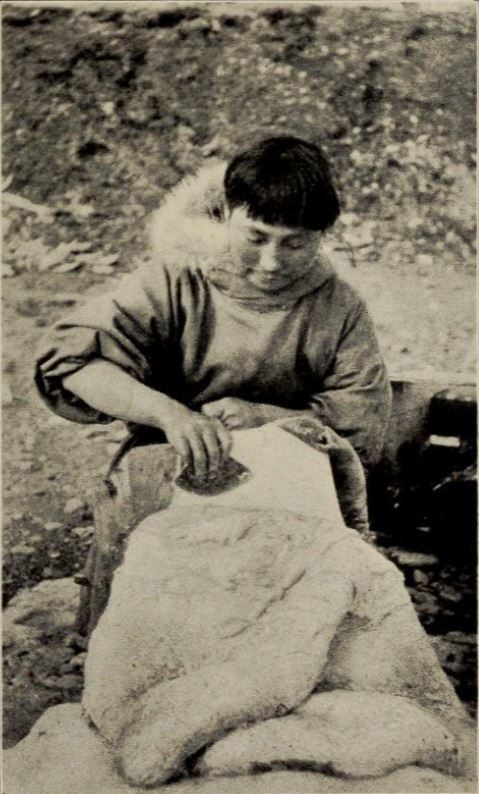
Image from "The Adventure of Wrangel Island" by Vilhjalmur Stefansson, Public Domain
Wrangel, Island.
June. 23d. 1923.
The daid of Mr. Knights death
He died on June 23d
I dont know what time he die though
Anyway I write the daid, Just to
let Mr Stefanssom know what month he
died and what daid of the month
writen by Mrs Ada B, Jack
- From the diary of Ada Blackjack, typewritten insert.
Although at the start of the trip she had been completely inexperienced in hunting, trapping, and other survival skills, Ada survived in the unforgiving wilderness of Wrangel Island for months. She reinforced the walls of the storage tent with driftwood, built a sleeping platform, made a stove out of empty kerosene cans, and built an observation deck on top of the tent to watch for polar bears. She built umiat, or skinboats, for hunting seals. She hunted birds, trapped foxes, collected eggs, and sewed warm clothes all while suffering from the symptoms of scurvy. She even sewed her son a pair of moccasins to give to him upon her return to Nome. Her journal paints an incredible story of her pains, struggles, and successes during the expedition. It can be read in its entirety online in the Dartmouth Digital Collections Library.
On August 20, 1923, Ada awoke to a noise outside her tent. She rushed outside and spied, breaking through the thick fog, a ship. She ran down to the beach, expecting to see the faces of Crawford, Maurer, and Galle looking back at her. But with the first few words spoken to her by Harold Noice, Stefansson’s associate, she knew that she was the only survivor.
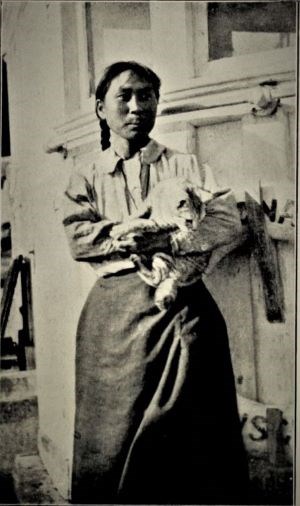
Image from "The Adventure of Wrangel Island" by Vilhjalmur Stefansson, Public Domain
The Only Survivor
After returning to Nome, Ada was met with frenzied attention from the press. She was largely hailed as a hero but was also met with suspicion and endured hateful rumors. Ada wanted none of the attention. Although Stefansson offered her less pay than he originally promised, Ada accepted it, desperate to reunite with Bennett. While Ada Blackjack’s story earned Vilhjalmur Stefansson tremendous profits and praise, Ada herself battled poverty for much of her life. Although promised royalties from Stefansson’s book based in part on her diary, she received nothing.On September 14, 1924, Ada gave birth to her second son, Billy Blackjack Johnson. Unfortunately, Ada soon contracted tuberculosis and was forced to place her two sons in an orphanage between 1927 and 1937 while she recovered. Ada lived in Seattle and Spokane before finally moving back to Alaska, where she continued to live a quiet and mostly private life.
But Ada Blackjack's legacy lived on. Countless others have been inspired by her story of determination and her will to live. Ada's second son, Billy Blackjack Johnson, served in the Army and was stationed in Germany from 1945 to 1948, after which he moved to Seattle with his wife. Throughout his life, he was active in many Alaska Native organizations and a registered lobbyist before passing away in 2003. Sadly, Ada's first son, Bennett Blackjack, suffered from chronic tuberculosis and other debilitating illnesses for the rest of his life and eventually passed away in 1972 at age 58. Ada followed him ten years later at age 85 on May 29, 1983, at a nursing home in Palmer, Alaska. She is buried at the Anchorage Memorial Park Cemetery, where her headstone reads, “Heroine - Wrangel Island Expedition.”
Sources:
“Ada Blackjack Rising.” Ada Blackjack Rising - YouTube
“Ada Blackjack: Sole survivor of doomed Wrangel Island expedition.” Anchorage Museum, 2021. Ada Blackjack: Sole survivor of doomed Wrangel Island expedition - Anchorage Museum at Rasmuson Center
Blackjack, Ada. “Ada Blackjack Diary.” Dartmouth Digital Collections. Ada Blackjack Diary | Dartmouth Library
“Guide to the Billy Blackjack Johnson papers.” Archives and Special Collections of the UAA/APU Consortium Library. Billy Blackjack Johnson papers - Archives and Special Collections (consortiumlibrary.org)
“Historical Spotlight: Ada Blackjack.” Bering Straits Native Corporation, 2020. Historical Spotlight: Ada Blackjack (beringstraits.com)
Mulvaney, Kieran. “The Inuit Woman Who Survived Alone on an Arctic Island After a Disastrous Expedition.” History.com, 2021. The Inuit Woman Who Survived Alone on an Arctic Island After a Disastrous Expedition - HISTORY
Stefansson, Vilhjalmur. “The Adventure of Wrangel Island.” 1925. The adventure of Wrangel Island : Stefansson, Vilhjalmur, 1879-1962 : Free Download, Borrow, and Streaming : Internet Archive
Tetpon, John. “Ada Blackjack Johnson – An Epic Story of Arctic Survival and the Will to Live.” 2023. John Tetpon: Ada Blackjack Johnson (beringstraits.com)
Webb, Melody. “Arctic Saga: Vilhjalmur Stefansson's Attempt to Colonize Wrangel Island.” Pacific Historical Review, Vol. 61, No. 2. May, 1992. Arctic Saga: Vilhjalmur Stefansson's Attempt to Colonize Wrangel Island on JSTOR
